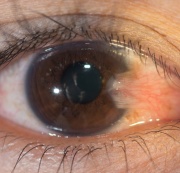Contents |
Pterygium
A pterygium (turr-i-gee-um) is a benign triangular-shaped growth or plaque that usually arises in the nasal corner of the eye, extending from the white sclera towards the clear cornea. While it is possible for a pterygium to occur on the side of the eye closest to the temple, about 90% of them originate on the nasal side.
A smaller, less disruptive type of growth called a pinguecula can occur and there is some evidence that these small, yellowish-white plaques can convert into pterygiums. Both types of lesions are though to be caused by damage from ultraviolet light and harsh outdoor conditions.
This photograph shows a pterygium that has covered part of the cornea, which can lead to distortion and irregular astigmatism. The leading edge of the pterygium is almost to the edge of the pupil, where it will interfere directly with vision.
Pterygiums are generally considered to be a cosmetic problem because they usually don’t interfere with vision, but in some cases they can grow far enough onto the cornea to cause distortion and irregular astigmatism. A large pterygium can cause irritation, foreign body sensation and dryness of the eye, and if it grows far enough onto the cornea, it can cause vision disruption.
Pterygiums can start or stop growing at any stage; it can then remain stable for the lifetime of the patient, or begin to grow again without apparent cause.
Most researchers believe that overexposure to ultraviolet (UV) light damages the conjunctival tissue (the clear skin that covers the white of the eye and lines the inner eyelids) and this damage then causes the pterygium to form and grow. This is born out by the much higher incidence of pterygiums in people from tropical climates, particularly if they happen to spend a lot of their time outdoors without sun protection. Another name for pterygium is “Surfer’s Eye,” which defines another population that is prone to them. Other agents that could be implicated are irritants such as wind, dirt or chemicals that cause irritation.
Signs and symptoms
Some patients with pterygium experience discomfort and foreign body sensation, redness, burning or other dry eye symptoms as it becomes larger. Growth of a pterygium onto the cornea can cause distortion of the corneal surface which can cause irregular astigmatism that may not be correctible with eyeglasses; if it grows far enough, it can block light from entering the eye through the pupil behind the cornea.
Treatment
The best treatment is prevention of the pterygium’s growth by controlling the amount of UV light exposure to the eye. Protecting the eyes from sun damage with UV-blocking sunglasses, wide-brimmed hats and the liberal application of artificial tears (preferably those that are preservative-free). Avoidance of wind, dust and smoky conditions is also helpful.
Sunglasses should block 99% to 100% of all UV light, both UV-A and UV-B. A wrap-around style that minimizes not only UV light but also wind and dust. These should be used year-round because UV rays are present even on cloudy days. Also, side windows of cars do not usually block UV like the windshield does, so that can be another source of damage that is not obvious.
Those that participate in winter activities should also be aware of the possibility of damaging UV rays, from reflected light from the surface of the snow. Because much of this is reflected upwards, sunglasses that give adequate protection from other sources do not always do so in snowy conditions.
If the pterygium continues to grow, an eyecare practitioner can also prescribe anti-inflammatory eye drops with steroids to reduce the inflammation and quiet the conditions for growth. Vasoconstrictor eye drops can also be helpful over a short course of treatment, but these should not be used over the long term because they can cause a “rebound” effect, which may be worse than the original condition.
Surgical intervention can be considered to remove or re-direct a pterygium so it does not continue to affect the shape of the cornea. The decision to remove it depends on several factors, including symptoms, cosmetic improvement and the likelihood of vision changes in the future. Unfortunately, surgically removing a pterygium does not always end the problem, as it is quite common for them to recur from the same place; this happens more often in young adults, with almost all recurrences appearing relatively soon after surgery, usually within the first year. Regrowth can occur as quickly as six to eight months.
The rate of regrowth after surgical removal of a pterygium is almost 50%, but if a piece of the patient’s own conjunctival tissue can be transplanted into the area, regrowth occurrence is much less frequent, in the 5% to 10% range.
A thorough vision examination by an eyecare practitioner can detect the early stages of pterygiums so prevention will be more effective over the long term. It is much better to avoid surgical intervention later on by preventing further damage from occurring.






